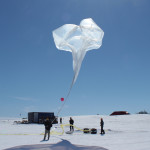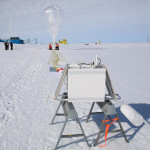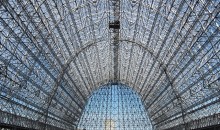A BARREL of Fun in Antarctica
Researchers from Dartmouth College in Hanover, N.H., with the support of NASA balloon scientists, are having a “BARREL” of fun in Antarctica.
The Balloon Array for Radiation belt Relativistic Electron Losses, or BARREL, is a unique mission that hopes to unravel the mysteries of radiation belts surrounding Earth.
To study this radiation belt, BARREL uses small scientific balloons—20 of them—to launch over Antarctica. The balloon-borne instruments will gather data on magnetic systems and send that information back to scientists on the ground. This information helps scientists to understand the particles that escape the radiation belts around Earth.
The BARREL program is the NASA Balloon Program Office’s first “Living with a Star” Announcement of Opportunity Awardee. This program enables science teams to conduct their own remote balloon field campaigns.
- Launch of a BARREL balloon at Halley Research Station on Jan. 30, 2014.
- Members of the BARREL team in Antarctica jump up and down in what they call the Low Wind Dance as they hope for the low wind conditions needed to launch another balloon.
- A BARREL balloon is inflated on Jan. 6, 2014 in front of Halley Research Station in Antarctica. The scientific payload is in the foreground and the parachute and balloon can be seen in the back.
- The 2013-2014 BARREL balloon campaign is underway — this balloon was launched on Dec. 31, 2013. BARREL’s job is to help unravel the mysterious radiation belts, two gigantic donuts of particles that surround Earth.
This is the second time BARREL has taken to the skies over Antarctica in part of the “Living with a Star” program. BARREL conducted a successful 20-balloon campaign over Antarctica from December 2012 to February 2013.
This year’s BARREL balloon campaign, with remaining flights planned, has already reached its comprehensive success requirements. The team has achieved more than 1,380 hours of observation time in the science field of interest.
NASA’s Balloon Program Office, located at NASA’s Wallops Flight Facility in Wallops Island, Va., provides programmatic support and management of the BARREL program. Prior to their two successful field campaigns, the BARREL team trained with Wallops and Columbia Scientific Balloon Facility teams to prepare them for the campaigns.
BARREL has a history with NASA’s Balloon Program, as BARREL instrumentation hitched a ride—or piggybacked—on NASA’s 7-million-cubic-foot Super Pressure Balloon.
NASA’s Balloon Program routinely launches payloads in Antarctica aboard balloons that can be as large as 40 million cubic feet. The balloons used for the BARREL mission are much smaller, only 0.3 million cubic feet, but can reach similar altitudes of nearly 130,000 feet because the balloons carry far less suspended weight.
The NASA Balloon Program has a year full of large-scaled missions from Hawaii, New Mexico and Antarctica.
via – NASA.






